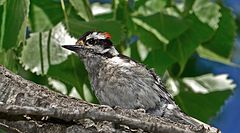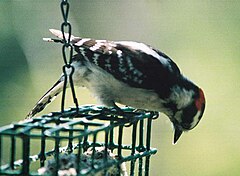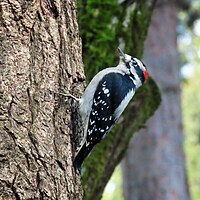Downy woodpecker

| Downy woodpecker | |
|---|---|
 | |
| Male | |
 | |
| Female | |
| Scientific classification | |
| Domain: | Eukaryota |
| Kingdom: | Animalia |
| Phylum: | Chordata |
| Class: | Aves |
| Order: | Piciformes |
| Family: | Picidae |
| Genus: | Dryobates |
| Species: | D. pubescens |
| Binomial name | |
| Dryobates pubescens (Linnaeus, 1766) | |
 | |
| Approximate distribution map Year-round | |
| Synonyms | |
| |
The downy woodpecker (Dryobates pubescens) is a species of woodpecker, the smallest in North America. Length ranges from 14 to 18 cm (5.5 to 7.1 in). Downy woodpeckers primarily live in forested areas throughout the United States and Canada, with the exception of deserts in the southwest and the northern tundra. The bird nests in tree cavities and feeds primarily on insects, although it supplements its diet with seeds and berries. The downy woodpecker is very similar in appearance to the hairy woodpecker, although they are not closely related.
Taxonomy
[edit]The downy woodpecker was described and illustrated with a hand-coloured plate by the English naturalist Mark Catesby in his The Natural History of Carolina, Florida and the Bahama Islands, which was published between 1729 and 1732.[2] When in 1766 the Swedish naturalist Carl Linnaeus updated his Systema Naturae for the twelfth edition, he included the downy woodpecker, coined the binomial name Picus pubescens and cited Catesby's book.[3] The specific epithet pubescens is the Latin for "pubescent" or "downy".[4] Linnaeus specified the type locality as America septentrionali (North America) but the locality is now restricted to South Carolina.[5] The downy woodpecker was usually placed in either Dendrocopos or Picoides, but a molecular phylogenetic study published in 2015 found that these genera did not form monophyletic groups.[6] In the revised generic classification, the downy woodpecker was placed with four other species in the resurrected genus Dryobates, that had been erected in 1826 by the German naturalist Friedrich Boie with the downy woodpecker as the type species.[7][8] Within the genus, the downy woodpecker is sister to a clade containing Nuttall's woodpecker (Dryobates nuttalli) and the ladder-backed woodpecker (Dryobates scalaris).[9]
Despite their close resemblance, the downy and hairy woodpeckers are not very closely related; the outward similarity is an example of convergent evolution. Why they evolved this way cannot be explained with confidence; it may be relevant that the species exploit rather different-sized foodstuffs and do not compete very much ecologically.[10][11]
Seven subspecies are recognized:[8]
- D. p. glacialis (Grinnell, 1910) – southeast Alaska
- D. p. medianus (Swainson, 1832) – central Alaska to east Canada and central and east USA
- D. p. fumidus (Maynard, 1889) – southwest Canada and west Washington
- D. p. gairdnerii (Audubon, 1839) – west Oregon to northwest California
- D. p. turati (Malherbe, 1860) – central Washington to central California
- D. p. leucurus (Hartlaub, 1852) – Rocky Mountains (southeast Alaska to southwest USA)
- D. p. pubescens (Linnaeus, 1766) – southeast USA
Description
[edit]
Adult downy woodpeckers are the smallest of North America's woodpeckers, but there are many smaller species elsewhere, especially the piculets. The total length of the species ranges from 14 to 18 cm (5.5 to 7.1 in) and the wingspan from 25 to 31 cm (9.8 to 12.2 in). Body mass ranges from 20 to 33 g (0.71 to 1.16 oz). Standard measurements are as follows: the wing chord is 8.5–10 cm (3.3–3.9 in), the tail is 4–6 cm (1.6–2.4 in), the bill is 1–1.8 cm (0.39–0.71 in) and the tarsus is 1.1–1.7 cm (0.43–0.67 in).[12][13][14] The downy woodpecker is mainly black on the upperparts and wings, with a white back, throat and belly and white spotting on the wings. There is one white bar above the eye, and one below. They have a black tail with white outer feathers barred with black. Adult males have a red patch on the back of the head whereas juvenile birds display a red cap.
The downy woodpecker is virtually identical in plumage pattern to the larger hairy woodpecker, but it can be distinguished from the hairy by the presence of black spots on its white tail feathers and the length of its bill. The downy woodpecker's bill is shorter than its head, whereas the hairy woodpecker's bill is approximately equal to head length.
The downy woodpecker gives a number of vocalizations, including a short pik call. One may identify the woodpecker by the pik-call, counting half a second between piks (a total of four must be heard). The rattle-call is a short burst that sounds similar to a bouncing ball, while that of the hairy woodpecker is a shorter burst of the same amplitude. Like other woodpeckers, it also produces a drumming sound (sounds like four taps[15] ) with its beak as it pecks into trees. Its drums are slower compared to other North American species.[16]
Behavior and ecology
[edit]Downy woodpeckers are native to forested areas, mainly deciduous, of North America. Their range consists of most of the United States and Canada, except for the deserts of the southwest and the tundra of the north. Mostly permanent residents, northern birds may migrate further south; birds in mountainous areas may move to lower elevations.[17]
Downy woodpeckers nest in a tree cavity excavated by the nesting pair in a dead tree or limb. In the winter, they roost in tree cavities. They tend to nest near soft snags,[18] where the wood is softer and the inner heartwood of the tree can be accessed more easily. The woodpecker will form a nest cavity in the softer heartwood, and its nest will be protected by the outer portion of the tree. This portion is made up of harder sapwood, which serves as protection from the elements and predators.[19] Heartwood is often softer in dead or decayed trees, as a result, the number of dead trees in a forest and downy woodpeckers habitats are positively correlated in studies.[18] Downy woodpeckers prefer to nest in areas with ample light, leading them to favor trees with broader leaves, such as poplars, birches, and ashes, or forest openings and edges.[20]
Downy woodpeckers forage on trees, picking the bark surface in summer and digging deeper in winter. They mainly eat insects, but they also feed on seeds and berries.[21] They are a natural predator of the European corn borer, a moth that costs the US agriculture industry more than $1 billion annually in crop losses and population control.[22][23] In winter, especially, downy woodpeckers can often be found in suburban backyards with mature trees where they feed on suet and shelled peanuts provided by mesh birdfeeders.
Breeding
[edit]Downy woodpeckers will start breeding in their first possible season and will return to a site within 2 hectares of where they were born.[20] They breed every year of their mature life, possibly returning to the same nest holes that they used in years prior. Barring the presence of an existing hole, downy woodpeckers will create a cavity in a tree roughly 2.4 to 15.3 m (8 to 50 ft) above the ground,[18] with the male woodpecker pecking the hole for roughly half of the daylight hours, in 20 minute work sessions. The nest hole takes about two or three weeks to create, and normally measures 12 to 15 cm wide and about 20 to 30 cm deep.[20]
A female will typically lay 4-5 white eggs, but can lay up to 7. During waking hours, both birds will incubate, or warm the eggs for 15 minute periods, taking turns in alternating shifts. At night, the male woodpecker typically will rest on the eggs for their continued warmth. This incubation period lasts for about 12 days. When the eggs hatch, the infant woodpeckers weigh about 1.6 grams, which will rise to around 3.2 grams over the course of its first day of life. They will appear fully grown by the 17th or 18th day.[20]
These younger birds are demarcated by tinted red crowns for the males, and striped or white dotted crowns for the females. Eventually, these crowns will turn jet black after they finish moulting in summer. The young males will also gain a bright red dot on the back of their head once they reach adulthood. The adult birds will begin to moult earlier than their young. This process starts when their young still occupy the nest, ultimately culminating with replacement of the two strongest, central feathers. These feathers are maintained to retain the bird's climbing power during the two month moult period. When the moulting ends in September, their plumage will have a slight yellow tinge.[20]
Gallery
[edit]- An adult female walking in Saskatoon, Saskatchewan
- A downy woodpecker hanging upside down
- Feeding on suet
- Male Dryobates pubescens in Overpeck Park, New Jersey, USA
- Downy woodpecker feeding chicks in New York City, USA
- Female with a leaf caught on her bill in New York City
- Male in New York City
- Bobbing downy woodpecker in Prospect Park, Brooklyn, New York, USA
- Downy Woodpecker Dryobates pubescens in Cambridge, Ontario, Canada.
- Female downy woodpecker (Dryobates pubescens) feeding on sunflower seeds.
- Downy woodpecker foraging at Fresh Pond in Cambridge, MA
- Downy Woodpecker on feeder
- Pajaro carpintero en Québec ville
- A Downy Woodpecker (male) in Oregon, United States
- Downy Woodpecker, South Meadows Trail, East Hartford, CT USA
References
[edit]- ^ BirdLife International (2016). "Dryobates pubescens". IUCN Red List of Threatened Species. 2016: e.T22681155A92894756. doi:10.2305/IUCN.UK.2016-3.RLTS.T22681155A92894756.en. Retrieved 12 November 2021.
- ^ Catesby, Mark (1729–1732). The Natural History of Carolina, Florida and the Bahama Islands. Vol. 1. London: W. Innys and R. Manby. p. 21, Plate 21.
- ^ Linnaeus, Carl (1766). Systema naturae : per regna tria natura, secundum classes, ordines, genera, species, cum characteribus, differentiis, synonymis, locis (in Latin). Vol. 1, Part 1 (12th ed.). Holmiae (Stockholm): Laurentii Salvii. p. 175.
- ^ Jobling, James A. (2010). The Helm Dictionary of Scientific Bird Names. London: Christopher Helm. p. 323. ISBN 978-1-4081-2501-4.
- ^ Peters, James Lee, ed. (1948). Check-List of Birds of the World. Vol. 6. Cambridge, Massachusetts: Harvard University Press. p. 211.
- ^ Fuchs, J.; Pons, J.M. (2015). "A new classification of the pied woodpeckers assemblage (Dendropicini, Picidae) based on a comprehensive multi-locus phylogeny". Molecular Phylogenetics and Evolution. 88: 28–37. Bibcode:2015MolPE..88...28F. doi:10.1016/j.ympev.2015.03.016. PMID 25818851.
- ^ Boie, Friedrich (1826). "Generalübersicht". Isis von Oken (in German). 18–19. Jena. Col 977.
- ^ a b Gill, Frank; Donsker, David; Rasmussen, Pamela, eds. (2020). "Woodpeckers". IOC World Bird List Version 10.1. International Ornithologists' Union. Retrieved 28 May 2020.
- ^ Shakya, S.B.; Fuchs, J.; Pons, J.-M.; Sheldon, F.H. (2017). "Tapping the woodpecker tree for evolutionary insight". Molecular Phylogenetics and Evolution. 116: 182–191. Bibcode:2017MolPE.116..182S. doi:10.1016/j.ympev.2017.09.005. PMID 28890006.
- ^ Moore, W.S.; Weibel, A.C.; Agius, A. (2006). "Mitochondrial DNA phylogeny of the woodpecker genus Veniliornis (Picidae, Picinae) and related genera implies convergent evolution of plumage patterns". Biological Journal of the Linnean Society. 87 (4): 611–624. doi:10.1111/j.1095-8312.2006.00586.x.
- ^ Weibel, Amy C.; Moore, William S. (2005). "Plumage convergence in Picoides woodpeckers based on a molecular phylogeny, with emphasis on convergence in downy and hairy woodpeckers". The Condor. 107 (4): 797–809. doi:10.1093/condor/107.4.797.
- ^ Woodpeckers: An Identification Guide to the Woodpeckers of the World by Hans Winkler, David A. Christie & David Nurney. Houghton Mifflin (1995), ISBN 978-0-395-72043-1
- ^ Downy woodpecker Species Account
- ^ Downy Woodpecker, Life History, All About Birds - Cornell Lab of Ornithology
- ^ Oklahoma City Community College and Cornell
- ^ Sibley, David Allen (2000). The Sibley Guide to Birds. New York: Alfred A. Knopf. p. 312. ISBN 978-0-679-45122-8.
- ^ Campbell, R. Wayne; Dawe, Neil K.; McTaggart-Cowan, Ian (1997-01-01). Birds of British Columbia Volume 2 : Nonpasserines : Diurnal Birds of Prey Through Woodpeckers. Vancouver, BC, CAN: UBC Press. ISBN 9780774856355.[permanent dead link]
- ^ a b c Schroeder, Richard (April 1983). "Habitat Suitability Index Models: Downy Woodpecker" (PDF). Retrieved October 17, 2023.
- ^ Washington Department of Fish and Wildlife. "Snags – The Wildlife Tree: The Importance of Snags in Your Neighborhood" (PDF). Retrieved October 17, 2023.
- ^ a b c d e Government of Canada, Public Services and Procurement Canada. "Information archivée dans le Web" (PDF). publications.gc.ca. Retrieved 2023-10-17.
- ^ "Downy Woodpecker | Audubon Field Guide". Audubon. Retrieved 2024-04-25.
- ^ "The European Corn Borer | The European Corn Borer". www.ent.iastate.edu. Retrieved 2017-11-13.
- ^ "European corn borer - Ostrinia nubilalis (Hubner)". entnemdept.ufl.edu. Retrieved 2017-11-13.
External links
[edit]- "Downy woodpecker media". Internet Bird Collection.
- Downy woodpecker - Picoides pubescens - USGS Patuxent Bird Identification InfoCenter
- Downy woodpecker Species Account - Cornell Lab of Ornithology
- Downy woodpecker photo gallery at VIREO (Drexel University)
- Downy woodpecker Bird Sound at Florida Museum of Natural History











